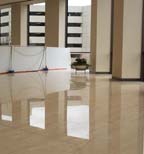
As part of a major commercial complex in downtown Houston, TX, Three Allen Center has a high profile in the community, and the managers at Trizec Properties, Inc. wanted to ensure that the building's aesthetics matched its status. With this goal in mind, the firm recently hired Marblelife of Houston to restore the 25-year-old travertine flooring in the main concourse.
The floor is comprised of 11,000 square feet of 2- x 4-foot panels, which had been installed when the building first opened 25 years ago. “The floor probably had a great deal of wax on it,†explained Jerry Maltz of Marblelife. “It had been maintained primarily by floor finishing. There was a lot of pitting and a lot of holes, and there were also some bad repairs that had been made by others over the years. The image they were trying to portray was a Class A look.â€
In addition to some very conspicuous patches, some of the processes used on the floor over the years had caused dips in the floor where water would pool. Maltz referred to these areas as “birdbaths.†“There was grinding in some places that had been done that left us with some terrible birdbaths to contend with,†he said. “We had to do a tremendous amount of grinding in those areas. There were spots in the corners where a tile was lipped and all four corners had simply been ground down. Also, there was a lot of missing grout.†The grout joints ranged from 1â„8 to 3â„16 inch.
Because Marblelife had worked with Trizec before, there were clear expectations for the scope of the work to be done. “We went through the property with Trizec and did the assessment,†Maltz said. “They are more concerned about quality than how cheaply it can be done. They are very much quality minded, and they are very concerned about [tenant] safety and lippage issues.â€

The restoration process
After stripping off the wax, Marblelife began the process of re-grinding the floor. “We think we have a fairly unique way of restoring floors. We have a grinding plate from Union Carbide that has 40 diamond-studded nubs on the bottom,†Maltz explained. “It allows us to grind a floor so flat that we can use Frankfurt abrasives -- from 60 grit up to 2000 -- to re-grind the floor.†By avoiding the use of diamond abrasives during the re-polishing step, the overall appearance is not “wavy,†according to Maltz. “We cannot restore a marble floor without making waves if we're using diamonds or higher speed equipment. We wanted to create a complete grind-in-place floor where the marble and the grout are all flush.â€After using Frankfurt abrasives up to a 60 grit, Marblelife backfilled the entire floor with Chemolite polyester resin from Chemor of Montreal, Quebec, Canada. “The holes were all filled. We liked their color of travertine flowing abrasive,†Maltz said. “On some of the big holes, there may be four or five different applications necessary.†The resin patches were mixed on site so the patches would match the unique pattern of each piece being repaired.
After the floor was backfilled, the Frankfurt polishing continued up to a 2000 grit, and the floor was then polished with Marblelife Gold Plus Gloss restorer, a wet polishing abrasive for marble. “We were trying to achieve as close to a factory finish as possible,†he said. “Then we came back about four days later, after it had really dried, and we finished it off with Interstage Hardener G, which was sprayed on and buffed off. We do that to put the clarity back in the stone and get some of the 'clouding' out.â€
By using the diamond grinding plate during the first step, the grout lines are flush with the stone, which keeps the grout clean over the long term. “There are no depressions where the grout lines are,†Maltz said. “We started testing [the diamond grinding plate] 13 years ago, and we were getting results that we had never seen before. It was just about perfect. So then we have been grinding with Frankfurt stones for 13 years. We have tried planetary heads, but we cannot get the same level of flatness.â€
After using the diamond plate, crews also did some backgrouting of the grout. “About 90% of it is flush with the marble on the initial grind, and the rest is backgrouted,†he said.
Addressing the existing repairs were a bit of an obstacle for the crew. “Some of them were almost the size of a football,†Maltz said. “After we removed the decayed stone, we went all the way to the setting material. They were just chalk. But we got the job by fixing one of the stones that had had one of those repairs. We ground out all the decay, which was 3 feet long and 1 inch wide, and we showed Trizec Properties a sample of what we could do [with the polyester resin]. We are incredibly sensitive to making quality repairs as opposed to how fast it could be done. We deliver a high-end result.â€
Electricity was another problem, as the existing voltage would not allow the crews to run a buffer. As a result, Marblelife brought in its own booster to run the equipment. “The plates that we grind with for our Frankfurt bricks are 23 inches and 3â„8-inch plate steel. The drag is a lot, and we were burning out the motors.â€
The company began with six workers on the job, although only two workers were required to be on site for the duration, with Caster Davis of Marblelife managing the job. Overall, it took about six months to complete the restoration. “Since the building was open at full capacity, there was sometimes the issue of not having enough area to work,†Maltz said. “We did half the work during the daytime and half at night.†Some areas, such as the main corridor, could not be closed during business hours because they hosted the main traffic flow of the building. These sections were addressed during nights and weekends.
Now that the floor has been restored, it is mopped daily with InterCare Cleanser from Marblelife, and the company does some maintenance polishing with Marblelife Gold Plus periodically at the traffic lanes near the elevators and escalators. Marblelife's restoration work is also ongoing, as it is has also been addressing the interior stone walls and lower level at Three Allen Center.
